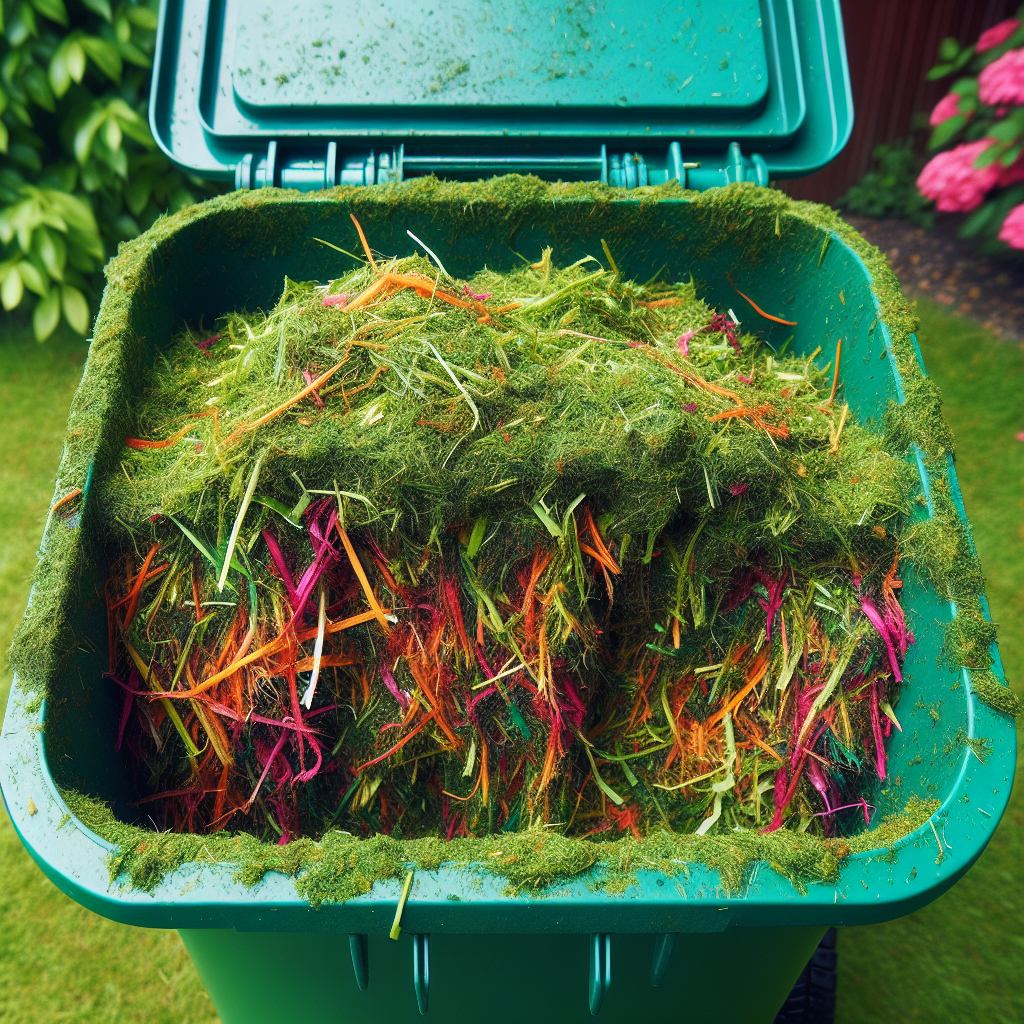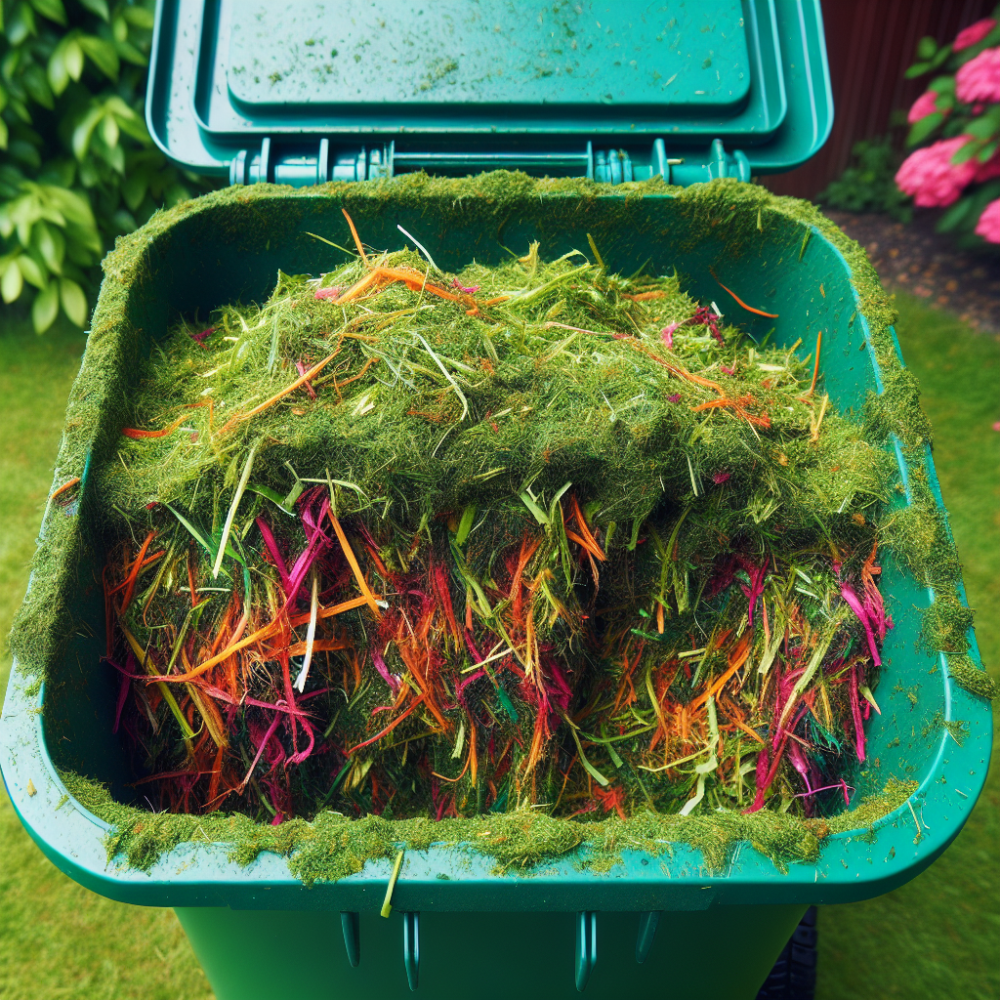If you’re wondering how to responsibly get rid of those grass clippings from your electric mower, you’re in the right place. With an increasing number of people opting for electric mowers over traditional gas-powered ones, it’s important to know the best way to handle the aftermath of your lawn care routine. In this article, we’ll explore some simple and environmentally-friendly methods for disposing of your grass clippings, ensuring they don’t end up as waste and instead can be recycled. So let’s get started and find out how you can be a responsible grass clippings owner!
Composting the Grass Clippings
Preparing the Grass Clippings for Composting
When it comes to disposing of grass clippings from your electric mower responsibly, one excellent option is composting. Composting is an eco-friendly way to repurpose your grass clippings and create nutrient-rich compost for your garden. Before you begin composting your grass clippings, it’s important to prepare them properly. Remove any large debris, such as twigs or rocks, from the clippings. It’s also a good idea to mix the clippings with other organic materials, such as leaves or kitchen scraps, to ensure a balanced compost.
Choosing the Right Composter
To effectively compost your grass clippings, you’ll need to choose the right composter for your needs. There are various types of composters available, including traditional compost bins, tumbling composters, and worm bins. Consider the space you have available, the amount of grass clippings you’ll be composting, and your desired level of involvement in the composting process. Each type of composter has its pros and cons, so make sure to research and choose one that suits your specific requirements.
Properly Composting the Grass Clippings
Once you have prepared your grass clippings and chosen your composter, it’s time to start composting! To properly compost your grass clippings, it’s important to follow a few key steps. First, make sure to layer your grass clippings with other organic materials, such as leaves or shredded newspaper, to promote proper decomposition. Turn the compost regularly to ensure proper aeration and breakdown of the materials. Keep the compost moist but not waterlogged, as excessive moisture can hinder the composting process. With time and patience, your grass clippings will transform into nutrient-rich compost that can be used to nourish your garden.
Using the Compost in Your Yard
Once your grass clippings have fully composted, you can reap the benefits of your efforts by using the compost in your yard. Spread the compost over your garden beds as a natural fertilizer to enrich the soil and promote healthy plant growth. You can also use it as a top dressing for your lawn to improve its overall health and vitality. The nutrient-rich compost will help retain moisture in the soil, reduce the need for additional fertilizers, and encourage beneficial microorganisms. By composting your grass clippings, you not only reduce waste but also create a valuable resource for your garden.
Mulching the Grass Clippings
Benefits of Mulching Grass Clippings
Mulching grass clippings is another responsible way to dispose of them. Instead of bagging and removing the clippings, mulching involves leaving them on the lawn as you mow. This technique offers several benefits. Firstly, mulching grass clippings acts as a natural fertilizer, returning nutrients to the soil. This reduces the need for synthetic fertilizers and promotes healthy plant growth. Secondly, mulching helps retain moisture in the soil, reducing the need for additional watering. Lastly, mulched grass clippings act as a natural weed barrier, suppressing weed growth and ensuring a healthier, more vibrant lawn.
Proper Techniques for Mulching Grass Clippings
To effectively mulch your grass clippings, it’s important to follow a few key techniques. Firstly, ensure that your electric mower is equipped with a mulching blade. This specialized blade is designed to finely chop the clippings and evenly distribute them on the lawn. Secondly, mow your lawn regularly and at the appropriate height. Cutting off no more than one-third of the grass blade at a time allows for optimal mulching. Lastly, avoid mulching wet grass clippings, as they can clump together and create an uneven application. Mulching works best when the grass clippings are dry.
Best Time to Mulch the Grass Clippings
The best time to mulch your grass clippings is during the growing season when the grass is actively growing. Ideally, you should mow your lawn when the grass is dry and at a height that allows for mulching without clumping. It’s important to note that excessive thatch buildup can hinder the effectiveness of mulching. Thatch is a layer of dead grass and debris that accumulates between the grass blades and the soil. If your lawn has excessive thatch, it’s recommended to dethatch before mulching to ensure optimal results.

Donating the Grass Clippings
Finding Organizations or Individuals Interested in Grass Clippings
If you’re looking for an alternative way to dispose of your grass clippings responsibly, consider donating them. Many organizations and individuals are eager to receive grass clippings for composting or as animal bedding. Local community gardens, organic farms, or even your neighbors may be interested in receiving your grass clippings. Check with your local gardening groups, agricultural organizations, or online platforms to connect with potential recipients. Donating your grass clippings not only reduces waste but also helps others in their gardening or farming endeavors.
Preparing the Grass Clippings for Donation
Before donating your grass clippings, it’s important to prepare them properly. Remove any large debris, such as rocks or sticks, from the clippings. Make sure the clippings are clean and free from contaminants, such as pesticides or herbicides. If you have been using chemical treatments on your lawn, it’s best to avoid donating those clippings. Bag the grass clippings in a biodegradable bag or a reusable container for easier transport and delivery to the recipient.
Donating the Grass Clippings
Once you have prepared your grass clippings for donation, it’s time to find a suitable recipient and arrange for the donation. Contact the organizations or individuals you have identified as potential recipients and inquire about their interest in receiving grass clippings. Coordinate the logistics, such as drop-off or pick-up arrangements, to ensure a smooth and convenient donation process. By donating your grass clippings, you not only support local gardening and farming efforts but also foster community engagement and sustainability.
Grasscycling the Clippings
Understanding Grasscycling
Grasscycling is the process of leaving grass clippings on the lawn after mowing, similar to mulching. However, grasscycling differs in that it involves mowing the grass at a higher height, allowing the clippings to decompose more quickly and blend into the lawn. Grasscycling is a simple yet effective way to recycle grass clippings and benefit your lawn’s health. It saves time and effort, reduces waste, and contributes to a greener environment.
Benefits of Grasscycling
Grasscycling offers numerous benefits for both your lawn and the environment. Firstly, it returns valuable nutrients to the soil, acting as a natural fertilizer. This reduces the need for synthetic fertilizers and promotes a healthier, greener lawn. Secondly, grasscycling helps conserve water by improving moisture retention in the soil. The clippings act as a natural mulch, reducing evaporation and preserving soil moisture. Lastly, grasscycling reduces waste by eliminating the need to bag and dispose of grass clippings, contributing to a more sustainable approach to lawn maintenance.
Practices for Effective Grasscycling
To ensure effective grasscycling, there are a few practices you should follow. Firstly, mow your lawn at a higher height, typically recommended at around 3 inches. This allows the grass clippings to blend into the lawn more easily and decompose quickly. As always, ensure your electric mower is equipped with a sharp blade to achieve a clean cut. Secondly, avoid mowing when the grass is wet, as it can lead to clumping and an uneven distribution of clippings. Lastly, be consistent with your mowing schedule to prevent excessive thatch buildup and maintain a healthy balance of clippings on your lawn.

Using the Grass Clippings as Animal Bedding
Precautions and Considerations
Using grass clippings as animal bedding can be a cost-effective and eco-friendly option. However, it’s essential to take certain precautions and considerations into account. Firstly, ensure the grass clippings are clean and free from contaminants such as pesticides or herbicides. Chemical treatments can be harmful to animals, so it’s best to avoid using clippings from treated lawns. Secondly, monitor the temperature and moisture levels of the bedding regularly. Grass clippings can generate heat as they decompose, so proper ventilation is crucial. Lastly, introduce grass clippings slowly into the animals’ living space and observe any adverse reactions or allergies.
Appropriate Animal Bedding Options
Several animals can benefit from the use of grass clippings as bedding. For livestock, such as horses or cows, grass clippings can work well as a supplemental bedding material, particularly in combination with other materials like straw or wood shavings. Small animals like rabbits or guinea pigs can also benefit from a layer of grass clippings in their bedding area, providing a soft and natural cushion. However, always ensure the grass clippings are clean and free from any potential hazards or toxins before using them as animal bedding.
Using Grass Clippings as a Natural Weed Barrier
Preparing the Grass Clippings as a Weed Barrier
Grass clippings can be repurposed as a natural weed barrier to help control unwanted weed growth in your garden beds. To prepare the grass clippings as a weed barrier, you’ll need to dry them thoroughly. Spread the clippings in a thin layer and let them dry in the sun for a few days. Once the clippings are completely dry, they can be used as a weed-suppressing mulch in your garden beds. It’s important to note that the clippings should be free of any weed seeds to prevent the spread of invasive plants.
Applying the Grass Clippings as a Weed Barrier
To effectively use grass clippings as a weed barrier, apply them as a thick layer around your plants or in between garden rows. Make sure the layer is approximately 2 to 3 inches thick to provide adequate coverage. The grass clippings will act as a physical barrier, preventing sunlight from reaching the weed seeds and inhibiting their growth. Additionally, as the grass clippings decompose, they will release nutrients into the soil and improve its fertility. Regularly monitor the weed barrier and replenish the grass clippings as needed to maintain its effectiveness throughout the growing season.
Creating Lawn Pathways with Grass Clippings
Preparing the Grass Clippings for Pathways
If you’re looking to add a natural touch to your lawn while repurposing your grass clippings, creating lawn pathways is a great option. To prepare the grass clippings for pathways, you’ll need to dry them thoroughly. Spread a layer of clippings in a thin, even layer and let them dry in the sun for several days. Rake the dried clippings to break up any clumps and create an even texture for the pathways. Remember to remove any debris or large particles that may interfere with the stability of the pathways.
Laying the Grass Clippings as Pathways
Once the grass clippings are thoroughly dried and prepared, it’s time to lay them as pathways in your lawn. Determine the desired paths and mark them with stakes or string to guide you during the installation process. Spread an even layer of the dried grass clippings along the marked pathways, ensuring a thickness of approximately 2 to 3 inches. Use a garden rake or your hands to smooth the clippings and create an even, defined pathway. Over time, the grass clippings will break down and blend into the lawn, creating natural and visually appealing pathways for you and your guests to enjoy.
Checking Local Regulations and Guidelines
Understanding Local Regulations for Grass Clippings Disposal
Before deciding on a disposal method for your grass clippings, it’s important to understand the local regulations surrounding their disposal. Different areas may have specific guidelines or restrictions in place to ensure proper waste management and environmental sustainability. Check with your local waste management authority or municipality to determine the regulations for grass clippings disposal in your area. Being aware of these regulations will help you make informed decisions about the best way to responsibly dispose of your grass clippings.
Finding Guidelines for Responsible Disposal
In addition to local regulations, there may be guidelines available that provide recommendations for responsible grass clippings disposal. These guidelines often offer insight into environmentally friendly disposal methods and practices that minimize the negative impact on the ecosystem. They may suggest options such as composting, mulching, or donating, which we have discussed earlier in this article. Some guidelines may also provide tips for minimizing contaminants in grass clippings or preventing the spread of invasive species. Taking the time to familiarize yourself with these guidelines will enable you to dispose of your grass clippings responsibly and in accordance with best practices.
Proper Bagging and Curbside Collection of Grass Clippings
Using Biodegradable Bags for Grass Clippings
If bagging and curbside collection is the preferred method for grass clippings disposal in your area, using biodegradable bags is an eco-friendly choice. These bags are designed to break down naturally over time, minimizing their impact on the environment. When bagging your grass clippings, choose bags specifically labeled as biodegradable and avoid using regular plastic bags. Fill the bags with the clippings, making sure not to overfill to prevent tearing or leakage. Once filled, securely tie the bags to prevent any accidental spillage during curbside collection.
Contacting the Waste Management Authorities for Collection
To ensure proper disposal of your grass clippings through curbside collection, it’s advisable to contact your local waste management authorities for specific instructions and schedules. They will provide you with the necessary information regarding collection days, whether the clippings should be placed in a separate container, or if they need to be bagged. Following the guidelines provided by the waste management authorities will help streamline the collection process and ensure your grass clippings are disposed of responsibly.
Proper Placement and Collection Procedures
When bagging grass clippings for curbside collection, it’s important to follow proper placement and collection procedures. Place the bags of grass clippings at the designated collection spot according to the instructions provided by the waste management authorities. Make sure the bags are easily accessible and clearly labeled as containing grass clippings to avoid any confusion. On collection days, ensure that the bags are placed outside before the designated pick-up time. By adhering to the proper placement and collection procedures, you can ensure a smooth and efficient disposal process for your grass clippings.
Considerations for Grass Clippings Disposal
Avoiding Contaminants in the Grass Clippings
When disposing of grass clippings responsibly, it’s important to avoid introducing contaminants into the environment. Contaminants can include substances such as pesticides, herbicides, or other chemicals that might have been applied to your lawn. These substances can have harmful effects on the ecosystem, including pollinators and beneficial insects. To prevent contamination, it’s best to avoid using grass clippings from chemically treated lawns and ensure that the clippings are clean and free from any potential hazards before disposing of them.
Preventing Spread of Invasive Species
Another consideration when disposing of grass clippings is the prevention of invasive species spread. Invasive plants can be present in your lawn, and their seeds or vegetative parts can be carried along with the clippings. To prevent the spread of invasive species, it’s crucial to inspect your lawn for any signs of invasive plants and remove them before mowing. Additionally, ensure that the grass clippings are free from weed seeds or invasive plant parts. This way, you can contribute to the protection of local ecosystems and prevent the further spread of invasive species.
Considering the Environmental Impact
Lastly, it’s important to consider the overall environmental impact of your grass clippings disposal methods. While some methods, such as composting or mulching, have minimal impact and even offer environmental benefits, others, like curbside collection, require energy and resources for transportation and processing. By choosing eco-friendly disposal methods whenever possible, you can reduce your carbon footprint and contribute to a more sustainable approach to lawn maintenance. Being mindful of the environmental impact of your actions is key to responsible grass clippings disposal.






